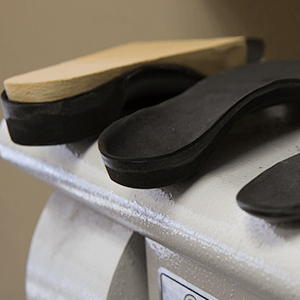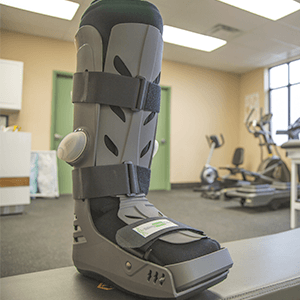Here are some conditions we can help you with.
Plantar fasciitis
Plantar fasciitis
Plantar fasciitis is one the most common causes of foot pain. It can strike at any age and can often linger for quite some time. There are a few key signs and symptoms that someone suffering from the condition will experience. Plantar fasciitis is most painful in the morning upon first arising out of bed, or after periods of rest. The pain tends to be reduced once the foot is “warmed up” or “loosened up” after a few minutes of walking. In chronic cases, the pain may last throughout the day as a dull ache, however the most intense pain will remain following rest.
Achilles Tendinitis (tendonitis)
Achilles Tendinitis
Pain as a result of Achilles tendonitis is found in the back of the leg/ankle along the tendon that joins the calf muscle (gastrocnemius and soleus) to the heel bone (calcaneus). This tendon provides the power necessary to propel the foot forward into the next step. It is usually as a result of an over-use issue or a “too much, too soon” problem. Most commonly the site of the pain is in the mid-point of the tendon (approximately 4cm above the heel), however it can affect the area where the tendon attaches onto the heel bone. In these cases, the condition is sometimes referred to as Achilles Enthesitis. Both Achilles tendinitis and enthesitis can become a lingering issue due to the fact that the tendon gets very little blood supply and therefore injuries can take a long time to heal.
Bunions
Bunions
Bunions or “Hallux Abducto-Valgus” are most often characterized by a large “bump” on the side of the joint at the base of the big toe. It is caused by a bone or tissue enlargement at the big toe joint that can cause the big toe to turn in towards the 2nd toe. The joint and surrounding tissues may be tender and swollen. Bunions can be caused by a number of different factors (or combination of factors), including: a family history of bunions, complicating biomechanical factors (eg. Overpronation), and ill-fitting footwear.
Metatarsalgia
Metatarsalgia
Metatarsalgia literally means forefoot (metatarsal) pain (algia). This broad term encompasses a number of conditions that affect the front of the foot. The most common use of this term is used to describe pain under the “ball of the foot” at the base of the toes. Depending on the underlying cause, a patient may feel either more or less pain when wearing footwear. For example, someone with a “pinched” or thickened nerve (Morton’s Neuroma) will often feel better when they take their shoes off. This is because the nerve is no longer being “squeezed” when inside the shoe. Conversely, someone with pain directly under the “knuckle” (metatarsal head) at the base of the toe will feel better when wearing shoes (particularly on hard floors). This is because the shoe provides a layer of cushioning between the knuckle head and the floor.
Morton's Neuroma
Morton’s Neuroma
Morton’s neuroma is an thickening of the nerve that runs between the toes (the “interdigital nerve”) as a result of chronic impingement (“pinching”) of the nerve. The most common site for a neuroma to develop tends to be between the 3rd and 4th toes. Often one of the easiest ways to determine if the pain is a result of a Morton’s Neuroma is to determine whether the pain is better or worse when wearing footwear. Often, in cases of Morton’s neuroma, the affected person feels much better when footwear (typically tight fitting) is removed. In these cases, the compression of the nerve caused by squeezing the foot into a tight shoe makes the pain much worse.
Hammer/Claw Toes
Hammer/Claw Toes
This is an arthritic condition of the toes that causes them to develop various levels of toe deformity. The “hammer toe” is characterized by a having the first joint of the toe (the proximal I-P joint) bent and the 2nd (furthest away) toe joint (the distal I-P joint) extended. This causes the middle “knuckle” of the toe to stick up and often causes it to rub excessively on the top of the shoe. This rubbing can lead to further thickening of the bone (hypertrophy) and this enlargement of the joint leads to even more rubbing on the footwear. This can make fitting into conventional footwear very difficult.
Related Products
Here are some of the products and services listed on our website to help give you some perspective of what we do and how we can help you. If you have any questions please email us, or book an appointment with one of our specialists.




